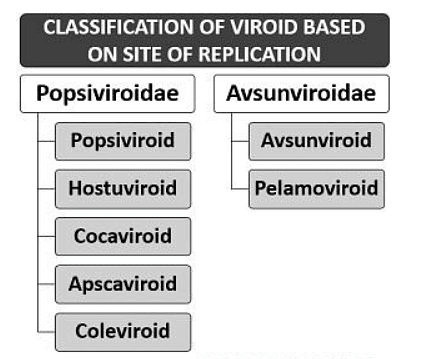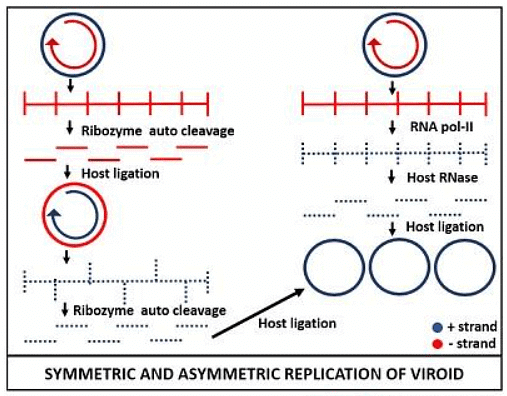Structure and Reproduction of Viroids | Botany Optional for UPSC PDF Download
Viroids
Viroids are a distinct category of infectious agents, smaller than viruses, and exhibit unique characteristics in their evolutionary origin, appearance, and functions.
In 1917, researcher Diener was the first to identify and coin the term "Viroids" to describe non-bacterial infectious agents that affect plants.
One of the initial viroids, Potato spindle tuber viroids (PSTV), was identified by T.O. Diener and W.B. Raymer in 1967. PSTV had a significant detrimental impact on potato crops, and its discovery unveiled the presence of infectious entities even smaller than viruses.
Meaning of Viroids
Viroids are tiny, non-cellular entities that belong to the category of sub-viral agents. They share similarities with viruses as obligate intracellular parasites but stand out by lacking a protective protein coat. Viroids typically consist of around 200-400 nucleotides.
Their main targets for infection, replication, and causing significant diseases are higher plants. The impact of viroids on their host species can vary, with differing levels of pathogenicity. Viroids often result in latent infections and, in some cases, can trigger chronic infections within the plants they infect.
Properties
- Viroids are the smallest known infectious agents and consist solely of tiny circular RNA molecules.
- Their RNA is covalently closed and lacks a protein coat.
- Viroids are akin to small nuclear RNA, consisting of a single-stranded circular RNA molecule.
- They were discovered by plant pathologist Theodor Diener in 1971, and the mechanism of how they infect host cells is still not fully understood.
- Viroids can sometimes cause severe damage in one plant while remaining symptomless in other plants of the same species.
- Viroids do not possess the ability to encode proteins.
- Their nucleotide sequencing is similar to that observed in transposons and retroviruses.
- Viroids are acellular particles, appearing smaller than viruses.
- They are considered as remnants of the RNA world, a time dominated by RNA before DNA and protein-based life forms evolved.
- Similar to viruses, viroids can move from cell to cell through plasmodesmata and spread systemically via the phloem.
- Viroids follow a replication cycle similar to that of viruses, functioning as obligate intracellular parasites.
- Their replication requires RNA polymerase II to synthesize messenger RNA from DNA, using viroid RNA as a template.
- Viroids can induce symptoms in higher plants through a process known as "RNA silencing."
Classification
Viroids are classified into two families, depending upon the site of replication.
Popsiviroidae
The family of viroids includes a group known as nuclear viroids, previously referred to as group-B viroids, and these viroids replicate within the nucleus of plant cells.
Within this family, there are different genera with their respective type species and genome sizes:
- Pospiviroid: This genus includes a type species known as Potato spindle tuber viroid, with a genome size ranging from 356 to 375 nucleotides.
- Hostuviroid: Another genus, Hostuviroid, encompasses a type species called Hop stunt viroid, with a genome size ranging from 295 to 303 nucleotides.
- Cocadviroid: Cocadviroid is a genus containing a type species known as Coconut cadangcadang viroid, with a genome size varying from 246 to 301 nucleotides.
- Apscaviroid: Within this genus, the type species is Apple scar skin viroid, and it has a genome size ranging from 306 to 369 nucleotides.
- Coleviroid: The genus Coleviroid includes a type species called Coleus blumei viroid, with a genome size varying from 248 to 361 nucleotides.
Avsunviroidae
The family of viroids also includes a group called chloroplastic viroids, previously referred to as group-A viroids, and these viroids replicate within the chloroplasts of plant cells.
Within this family, there are various genera with their respective type species and genome sizes:
- Avsunviroid: This genus includes a type species known as Avocado sun-blotch viroid, with a genome size ranging from 246 to 250 nucleotides.
- Pelamoviroid: Another genus, Pelamoviroid, encompasses a type species called Peach latent mosaic viroid, with a genome size varying from 337 to 399 nucleotides.
It's important to note that the location of replication differs depending on the type of plant species. Nevertheless, the replication process follows the same strategy involving three steps of RNA-based replication.
This replication cycle relies on three key enzymatic activities:
- Host DNA-dependent RNA polymerases
- Processing enzymes
- RNA ligase
Distinction Between Viruses and Viroids
- Viruses are nucleoprotein particles, while viroids are infectious RNA particles.
- Unlike viruses, viroids appear small and have a low molecular weight.
- Viroid only contains an RNA genome, whereas viruses may contain DNA or RNA. The infectious RNA replicates autonomously (without a helper virus) in the susceptible host cells.
Viroid Genome
The viroid genome is characterized by its small size, with a low molecular weight of around 1.1-1.3 X 105 Daltons (Da). Notably, viroids lack a protein coat that typically surrounds viral genomes, and they do not contain an AUG codon, which is responsible for initiating protein synthesis.
Viroids consist of a compact RNA molecule, usually in a circularized and unadorned form. The genomic RNA ranges from 250 to 370 nucleotides in length. These nucleotides tend to form pairs, creating double-stranded RNA (dsRNA) structures through intramolecular complementary regions.
As a result, viroids take on a rod-like structure, where the dsRNA regions are arranged in a closed, folded, and three-dimensional configuration. The viroid genome is typically organized into five domains:
The viroid genome is typically organized into five domains:
- Pathogenicity domain (P)
- Left terminal domain (TL)
- Central conserved domain (CCR)
- Variable domain (V)
- Rigid terminal domain (TR)
These folded regions within the viroid serve to protect the RNA against the action of cellular enzymes.
Replication of Viroids
The replication of viroids in higher plants involves a mechanism known as the RNA rolling circle mechanism, which relies on three enzymes.
There are two types of viroids with distinct replication processes:
- Symmetric Replication (Avsunviroids): In avsunviroids, replication is symmetric. This means that the viroid RNA template is copied in a manner where the resulting daughter strands are identical to each other.
- Asymmetric Replication (Pospiviroids): In pospiviroids, replication is asymmetric. This means that the viroid RNA template is copied in a way that the resulting daughter strands are not identical but complementary to each other.
The replication process requires three key enzymes:
- RNA Polymerase: This enzyme is responsible for synthesizing new RNA strands based on the viroid RNA template.
- RNase (Ribonuclease): RNase is an enzyme that cleaves RNA, and it plays a role in processing the viroid RNA during replication.
- RNA Ligase: RNA ligase is an enzyme that helps in joining or ligating RNA fragments together during replication.
These enzymes work together in the RNA rolling circle mechanism to replicate viroids in plants, with the specific mechanism (symmetric or asymmetric) depending on the type of viroid.
Asymmetric Replication
- Members of the Pospiviroidae family employ an asymmetric replication process, primarily relying on a host cell enzyme known as RNA polymerase II. This enzyme initiates replication by creating a break or nick in the cellular DNA, leading to the formation of both positive and negative strands.
- The positive circular strand serves as a template for the generation of new RNA through a rolling circle mechanism. Simultaneously, it triggers the synthesis of messenger RNA (mRNA) from the cellular DNA and forms a large linear multimeric (-) strand by using the circular (+) RNA strand of the viroid.
- Subsequently, the Pospiviroids proceed to create a (+) sense RNA from this extended linear molecule through an asymmetric replication pathway. It's important to note that the (+) RNA strand of the viroid is susceptible to the RNase activity of the host cell.
- As a result, the RNase enzyme cleaves the (+) RNA strand of the viroid into individual viroid-length fragments. These unit fragments of the (+) RNA strand then undergo ligation to reconstitute the viroid as a circular (+) RNA molecule.
Symmetric Replication
Avsunviroids differ from other viroids as they lack a central conserved region and possess ribozyme activity instead of relying on RNA polymerase. This ribozyme activity enables the large multimeric (-) RNA strand to undergo self-cleavage, a property known as auto cleavage.
Following auto cleavage, the replication intermediates join together into a (-) circularized RNA. Subsequently, a second rolling circle event occurs, resulting in the formation of a long linear (+) RNA strand. Again, ribozyme activity cleaves this strand, eventually leading to the fragments of viroid RNA ligating into a (+) circular RNA.
Viroid genome replication can occur through two possible mechanisms:
- RNA-Directed Replication: In this mechanism, RNA polymerase synthesizes RNA molecules based on the guidance of the viroid RNA itself.
- DNA-Directed Replication: In this alternative mechanism, viroid RNA forms after the transcription of the host cell's DNA, complementary to the viroid RNA. The viroid RNA then generates new DNA within the infected cell through the involvement of the reverse transcriptase enzyme.
 Reverse transcriptase acts as an RNA-directed DNA polymerase, producing viroid RNA using the infected DNA as a template.
Reverse transcriptase acts as an RNA-directed DNA polymerase, producing viroid RNA using the infected DNA as a template.
These studies have led to two significant conclusions: viroids can replicate directly via RNA-to-RNA copying, and it is possible that the host cell's machinery plays a role in facilitating viroid RNA replication.
|
179 videos|143 docs
|





















